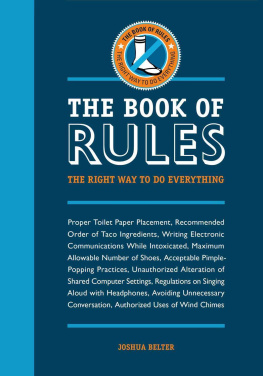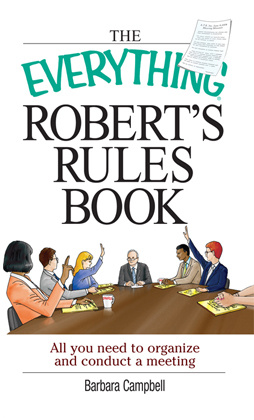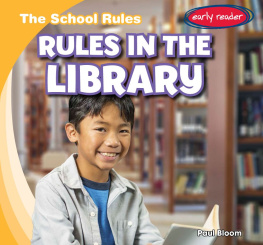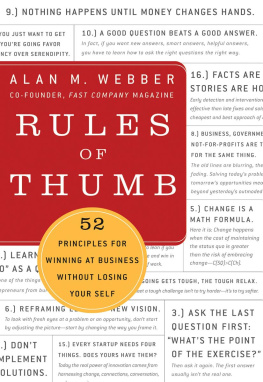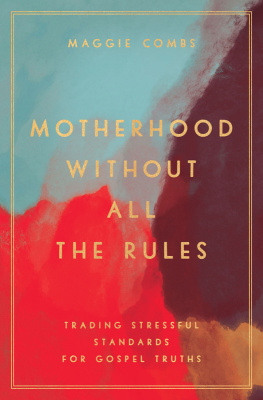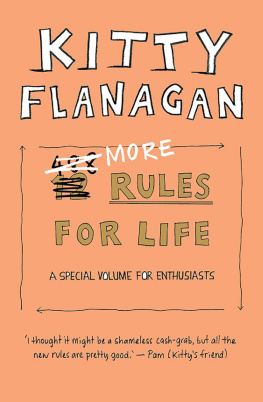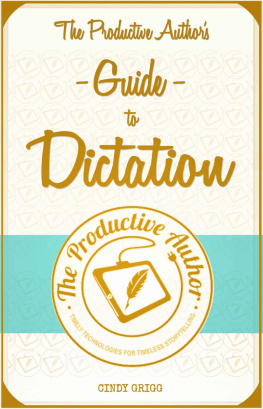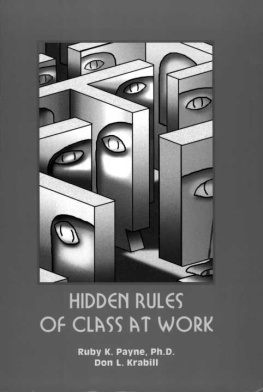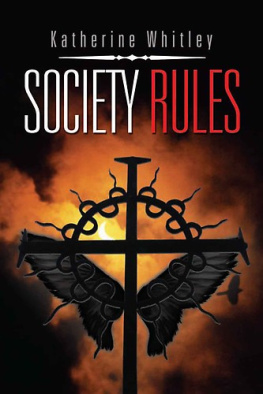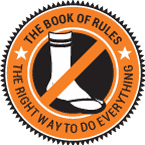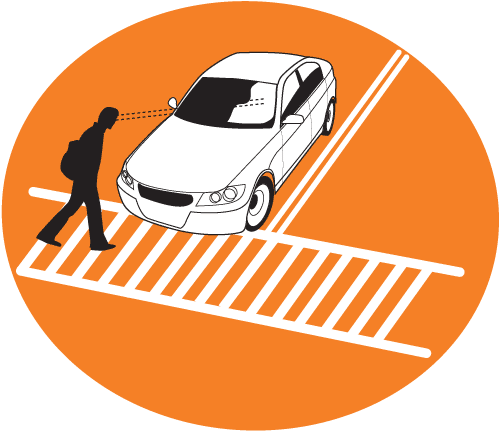Thank you for purchasing this How Design eBook.
Sign up for our newsletter and receive special offers, access to free content, and information on the latest new releases and must-have designing resources! Plus, receive a coupon code to use on your first purchase from MyDesignShop.com for signing up.
or visit us online to sign up at
http://howdesign.com/ebook-promo
TABLE OF
CONTENTS
1
SCOPE
BOR 1-1 Purpose
The Book of Rules (BOR) was established to outline acceptable practices and procedures in various social situations. Many everyday actions, while not illegal or immoral, are generally considered improper and are outlined within this handbook. This manual establishes and reinforces life rules required to be a productive member of American society.
A. The BOR is applicable to all citizens of the United States and all of its territories. Although not specifically mandated for citizens outside of the United States, most BOR regulations are generally accepted worldwide.
BOR 1-2 Jurisdiction
State and federal law override this handbook whenever specific statutes contradict individual rules or requirements of the BOR. Good judgment shall be utilized when individual statutes are in question. Additionally, specific regulations may be contrary to the religious beliefs of an individual. In such cases, individual regulatory exclusions specific to religious beliefs are permissible.
A. Use common sense.
BOR 1-3 Reference
A copy of the BOR shall be kept readily available for reference at all home and work locations. BOR D-1 Discrepancy Forms (see ) shall also be readily available and may be utilized as required. Previous versions are obsolete and shall be replaced within thirty days of the effective date of updated publications.
BOR 1-4 Definition of Terms
SHALL implies an action, motion or procedure is mandatory.
MAY implies an action, motion or procedure is optional.
WILL implies a future action is mandatory.
INDIVIDUAL refers to a single person or group of people.
EXCEPTIONS detail situations in which a specific BOR regulation may be ignored. Exceptions are generally not inclusive, and good judgment shall be exercised when considering exceptions not detailed in this manual.
PHRASEOLOGY EXAMPLE details verbatim phrases requiredor acceptable phrases allowablein various situations.
BOR 1-5 Discrepancy Forms
All American adults have a primary responsibility to issue BOR D-1 Discrepancy Forms to individuals when violations to the BOR are personally observed. No other action is warranted or required. The violator alone has the specific requirement to ensure that corrective measures will be taken to become compliant with the BOR.
A. The BOR D-1 Discrepancy Form is located in Appendix A of this publication.
B. Additional BOR D-1 Discrepancy Forms may be ordered at www.thebookofrules.com.
BOR 1-6 Authorized Deviations
Individual exclusions from any regulation contained within The Book of Rules are permissible whenever compliance with this manual may jeopardize the safety of others. The phrase Safety Exception followed by the specific BOR regulation violated shall be clearly expressed whenever a BOR regulation is intentionally violated in the presence of others.
PHRASEOLOGY EXAMPLE: Safety Exception 3-1
NOTE: Local and regional customs or procedures may warrant deviations from individual regulations contained within the BOR. Prior to implementing formal individual or organizational exclusions, permission shall be obtained from the BOR Regulatory Board at www.thebookofrules.com.
BOR 1-7 Submissions
Unsolicited submissions regarding amendments and additions to the BOR are encouraged. Changes may be proposed in writing by completing the BOR S-1 Submission Form (see . Submissions become the property of the BOR Regulatory Board after receipt and will not be returned. The inclusion decision will be determined solely by the BOR Regulatory Board.
2
DRIVING
BOR 2-1 Crossing the Path of a Vehicle
Pedestrians crossing the path of a motor vehicle shall make personal eye contact with the driver prior to initiating passage across the path of the vehicle. If eye contact is not initiated, the driver of the vehicle is warranted to honk the horn, yell loudly and aggressively wave his or her fist. Vulgarity is only authorized when a violating pedestrian is operating a cell phone (see C).
A. Pedestrians more than halfway across the street when a vehicle approaches are not required to initiate eye contact with drivers.
BOR 2-2 Limiting Unnecessary Driving
Driving a motorized vehicle is only authorized when the distance between the departure and destination location exceeds 200 yards. Driving across the street and other needless trips are considered excessive and wasteful. Unnecessary driving contributes to obesity and wastes fuel.
BOR 2-1. Pedestrians crossing the path of a motor vehicle shall make personal eye contact with the driver prior to initiating passage across the path of the vehicle.
A. Allowable vehicle operations less than 200 yards:
1. Moderate or greater precipitation is currently occurring (see A1a).
2. Physical restrictions of the driver or any passenger prohibit walking.
3. A song, program or talk show warrants additional listening.
4. The transport of heavy objects would make walking impractical.
5. The movement of a vehicle is required for maintenance of said vehicle.
BOR 2-3 The Green Light Honk
When stopped at a red light behind one or more vehicles, all vehicles ahead of a driver are allowed 3 seconds to accelerate after the light turns green. Honking the horn is permitted and encouraged after the mandatory 3-second wait period has expired. After any vehicle initiates a Green Light Honk, successive honks are forbidden unless an additional 3 seconds have passed since the previous Green Light Honk.

